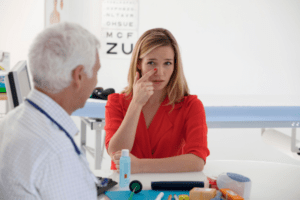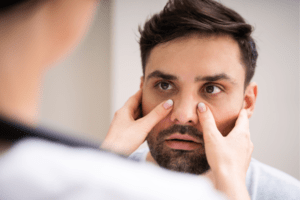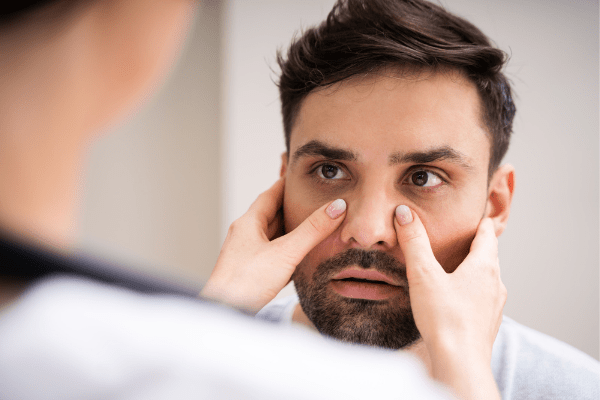Sinus inflammation (sinusitis) is a common condition that is diagnosed in more than 30 million Americans every year. It is an irritating condition that can cause a lot of discomfort, affects one’s quality of life, causes recurrent infections and even some degree of facial pain and headaches.
The symptoms vary depending on the severity of your condition, but they are always lingering and tend to get worse over time. Many people use antibiotics, nasal saline rinses, and nasal steroid sprays to ease the symptoms. However, the relief is usually temporary in most cases. Fortunately, surgery offers long-term relief — and it doesn’t hurt at all in Dr. Cohen’s expert hands.
Minimally Invasive Sinus Surgical Solutions
Surgery is the most effective treatment for sinus inflammation. However, many people are afraid that it will hurt or leave a mark on the face. However, this isn’t a cause for concern with minimally invasive in-office surgery options. Treatment is quick, efficient, and involves minimal discomfort. Furthermore patients are back to normal functioning usually 24-48 hours after the procedure with Dr. Cohen.
There are several minimally invasive in-office sinus surgery solutions, including:
Balloon Sinuplasty
Balloon Sinuplasty is an FDA-approved innovative and painless procedure effective against most sinus inflammation conditions. It involves using an endoscope, camera, and balloons to unblock the sinuses. It’s angioplasty of the sinus openings per say!
Dr. Cohen inserts an endoscope and camera into the sinus to inspect the level of congestion. He then positions a lighted guide-wire threaded with a balloon catheter through the congested sections. The balloons are inflated for between five and ten seconds, dilating the blocked sinus openings.
Dr. Cohen uses a local anesthetic to keep you comfortable and this is topical and requires no injections. As such, the discomfort is minimal, and the experience is not painful. Patients recover over a couple of days, and a single procedure can be effective for decades in Dr. Cohen’s expert hands.
Deviated Septum Repair
Septoplasty is a minimally invasive procedure effective against mild and severe cases of a deviated septum. The septum, the wall between the nasal passages, can be crooked because of trauma or deformity at birth. This procedure is designed to straighten the septum with minimal pain or discomfort.
Septoplasty involves making a half-inch incision inside the nose to get access to the septum. The surgeon then reshapes the septum without breaking bones or tearing tissue. Consequently, there is minimal bleeding, and there are no signs of the procedure on the surface — patients don’t have to wear a cast on the nose. Recovery takes less than a week.
This is most commonly performed in the surgical center as an outpatient in under 1 hour and patients are home to recover without nasal packing over the next 3-5 days. Most patients report taking pain meds only for the first 1-3 days and then using Tylenol.
Nasal Polypectomy & Turbinate Reduction
Nasal polypectomy and turbinate reduction procedures are recommended for sinus inflammation that is severe leading to polyps and significant turbinate hypertrophy. This technique is performed in the office in the majority of patients who do not have a deviated septum. Often Dr. Cohen uses a tiny microdebrider to remove the inflammatory polyps and shrink the turbinates to permanently prevent recurrence in his patients. The procedure requires a local anesthesia to minimize discomfort, but it doesn’t involve cutting or bruising.
Minimally Invasive Image-Guided Endoscopic Sinus Surgery
This procedure is recommended for sinus inflammation caused by infection, polyps, and scar tissue that is advanced and cannot safely be performed in the office under local anesthesia. It is also often done in combination with a deviated septum repair and turbinate reduction in the outpatient surgical center setting. This procedure entails using a micro-debrider to remove the scar tissue and polyps blocking the sinus. The procedure may also necessitate using an image-guided approach, especially when the scar tissue is extensive and extends deep within the sinuses. This procedure usually takes up to an hour to finalize, depending on the extent of the inflammation and blockages. Patients usually head home one hour after the procedure and heal over 3-5 days with minimal pain meds. The full results are seen 2-4 weeks after surgery but patients usually return to work 5 days after this procedure.
Revision Sinus Surgery
Dr. Cohen manages tons of patients who underwent nose/sinus surgery elsewhere and have had a recurrence of their problems. Surgery doesn’t always work for everyone suffering from sinus inflammation. It could be because of recurring polyps or a botched surgical procedure. Whatever the case, revision sinus surgery with expert nose and sinus surgeon, Dr. Cohen, will often remedy the problem and offer long-term relief for these patients. At times he will select in-office image-guided sinus surgery and balloon sinuplasty under local and in more severe cases he will recommend outpatient image-guided sinus surgery. The extent of procedure really depends on the extent of blockage and disease that he has to treat. Nonetheless patients routinely say that the procedure with him is nothing like their previous surgeries and is a breeze to go through and heal from with minimal discomfort.
Eustachian Tube Dysfunction Treatment
Surgical solutions for eustachian tube dysfunction treatment are traditionally invasive. However, Dr. Cohen has been adopting a new minimally invasive approach called the Stryker Xpress ENT Dilation System.
This system eliminates the pain and discomfort associated with traditional procedures, and patients report zero complications. It is also more efficient, and patients can get it done in 20 minutes in the office under local anesthesia. Results are seen 4-6 weeks after the procedure.
ClariFix Freezing Treatment for Rhinitis
ClariFix is a new innovative procedure recommended for chronic rhinitis and sinus inflammation refractory to other treatments. This procedure is again performed in the office under local anesthesia and entails freezing inflamed tissue inside the nasal passages. Freezing these tissues reduces inflammation and makes them less inflamed and so minimizes chronic congestion and runny nose symptoms permanently for affected patients.
The FDA approved ClariFix a few years ago and research shows long-lasting results for four out of five patients. However, effects can take up to six weeks to materialize, depending on the condition’s severity. It is also worth noting that the surgeon may recommend medicine to manage the symptoms until relief becomes permanent.
LATERA Nasal Valve Repair
Nasal obstruction may often be due to collapsed or weak nasal cartilage. It is an innovative procedure that strengthens the nasal cartilage to minimize symptoms of nasal collapse long term.
LATERA is a nasal implant designed to support weakened cartilage. The implant functions as secondary support when first inserted. However, it gets absorbed into the nasal cartilage over time, making it naturally stronger. This procedure is minimally invasive and has cosmetic benefits — in addition to treating sinus inflammation.
The Benefits of Minimally Invasive Sinus Surgery
Minimally invasive sinus surgery has a range of benefits, including:
Fast Results & Recovery
Most of the solutions discussed above work within minutes or hours, and the effects can last permanently in Dr. Cohen’s expert hands as a board-certified rhinologist. What’s more, many patients recover within 24 to 48 hours, while some of the more complex procedures take within a week to heal.
Minimal Discomfort
Traditional surgery is usually invasive and involves a higher degree of pain and discomfort compared to minimally invasive surgical procedures. To this end, patients can receive treatment and go back about their activities almost immediately after the procedure.
Affordable
These minimally invasive surgical procedures cost a fraction of the cost of traditional surgical procedures. They also cost much less than using OTC and prescription medicine for years.
Final Thoughts
Surgery is the most effective treatment for chronic nasal congestion and chronic sinus inflammation. It offers almost immediate relief, and the effects can be permanent when performed by an expert nose and sinus specialist. It doesn’t hurt, either, thanks to these minimally invasive surgical procedures when done by Dr. Cohen.
Feel free to contact Dr. Alen N. Cohen, M.D. F.A.C.S. today to learn more about sinusitis and how we can help.

